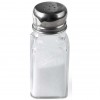Abstract
Reducing sodium intake is one of the MyPlate recommendations for healthy eating. Most Americans eat more sodium than they need, which can have negative health effects. This publication provides facts about sodium and why reducing sodium intake is important. It also provides easy tips to reduce your sodium intake. This 4-page fact sheet was written by Ashley Hamm, Karla P. Shelnutt, and Gail P. A. Kauwell, and published by the UF Department of Family Youth and Community Sciences, April 2013.
References
Foods High In.net. (2012). Nuts, seeds, and spices high in sodium. Retrieved from http://foods-high-in.net/foodshigh-in-sodium/nuts-seeds-and-spices,8.html
Institute of Medicine. (2005). Dietary reference intakes for water, potassium, sodium, chloride, and sulfate. Washington, DC: The National Academies Press.
Mayo Clinic. (2011). Sodium: How to tame your salt habit now. Retrieved from http://www.mayoclinic.com/health/sodium/NU00284/NSECTIONGROUP=2
United States Department of Agriculture. (2011, June). Salt and sodium: 10 tips to help you cut back. Retrieved from http://www.choosemyplate.gov/food-groups/downloads/TenTips/DGTipsheet14SaltAndSodium.pdf
U.S. Food and Drug Administration. (2010, May 18). Lowering salt in your diet. Retrieved from http://www.fda.gov/ForConsumers/ConsumerUpdates/ucm181577.htm
Unless otherwise specified, articles published in the EDIS journal after January 1, 2024 are licensed under a Creative Commons Attribution-NonCommercial-NoDerivs 4.0 International (CC BY-NC-ND 4.0) license.

